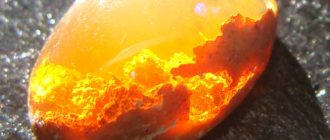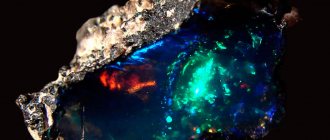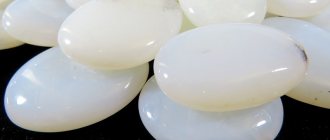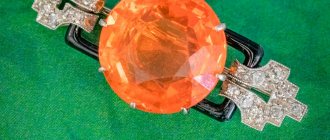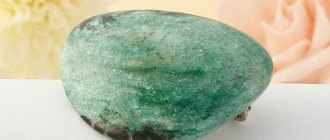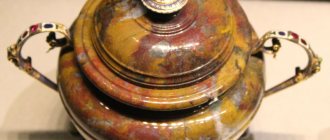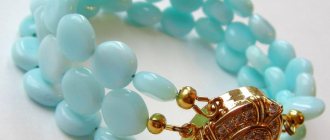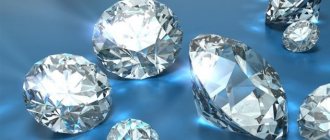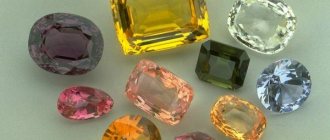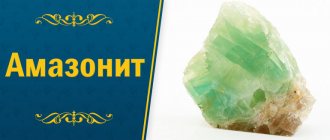What is synthetic opal?
Externally, synthetic opal is practically indistinguishable from natural opal. High-quality fakes have physical characteristics identical to the mineral, with some improved features.
The color palette of synthetic stones includes any possible shade. Tone is imparted by diffraction without the use of dyes.
In artificial gems there is an increased density and there is no water in the composition.
In addition, the breed has certain advantages over its natural counterpart:
- cheapness;
- bright, rich color;
- beautiful shine;
- resistance to external factors;
- hardness.
How to distinguish a real opal from a fake?
The more expensive and beautiful the stone, the greater the temptation to create its analogue, and the more questions consumers have when purchasing a product.
Here's how to distinguish natural opal from imitation:
- An unusual but accurate way to check the authenticity of an opal is to place the stone on your tongue: if it is artificial, it will stick, which will not happen with a real nugget.
- Under the influence of sunlight, a natural stone lying on the palm will color it in a rainbow color. If the buyer is faced with a fake, such overflows will be absent.
- Patterns. If the opal is real, the patterns in its interior are not repeated, and the color of the mineral remains uniform. If the stone is artificial, you can observe a change in its brightness, and the patterns will be the same.
- Multi-layering. Sign of synthetic opal. Layers are strips, parts attached to each other. A natural mineral cannot have a similar structure.
- Transparency. If the stone has a pure, milky white color, this is a property of natural opal. If a darker base is visible, the stone is synthetic.
- Bubbles. If you can look at the stone under a magnifying glass, the artificial stone has miniature cracks filled with air. These bubbles are formed due to temperature changes during glass processing.
- Stones of very rich colors - bright pink, poisonous green - are usually fake.
Gemological examination is the most reliable method of checking the authenticity of an opal, however, it is paid. But the methods described will help prevent fraud on the part of unscrupulous suppliers.
How the gem was created
Synthetic opal ring
Humanity learned to artificially reproduce opals back in ancient times. In Ancient Rome, cheap analogues of the mineral were made from hot glass. To do this, it was heated and sharply cooled to simulate microcracks and inclusions characteristic of the stone.
The patent for the production of artificial opals was first acquired by mineralogists from Australia A. Gaskin and P. Darré in 1964. At the first stage of the synthesis, scientists produced silica spheres of the required size. Since the balls formed under artificial conditions contained more water than in natural opal, the next step was dehydration and gluing of the spheres using heating.
Around the same time, scientists in Delaware succeeded in producing spherical silica particles with an ideal diameter of 0.1 microns. In the intermediate layer between the balls, the bright colors of noble natural opal were observed. Addition of hydrochloric acid to the solution resulted in the formation of solid particles with a full spectrum of colors. This is how the first lab-grown opal appeared, with the play of colors characteristic of the rock.
The synthesis process was improved and was later supplemented by the use of organic silicon compounds with the addition of ammonia. Heating technology continued to be used to compact the balls in order to reduce the voids between them.
Synthetic opal
And in 1973, the Swiss organization of Pierre Gilson began producing high-quality synthetic gems in a wide variety of variations. Gems are in no way inferior to natural ones and even have opalescence. Gilson samples are characterized by a certain porosity. The stones become transparent only after immersion in chloroform. The color of the stones is close to natural samples of black and milky white. The patterns and opalescence are also almost identical to the originals.
There are four leading manufacturers in the world:
- The Japanese company Kyotsera, famous for opals made from various layers, impregnated with transparent colorless rubber.
- Slocum, which produces rock from a special glass with a velvety shine.
- Gilson's company. Creates stones from layers of natural opal with an artificial base.
- Inamori Corporation, which reproduces a breed almost identical to the natural one in chemical characteristics.
These organizations produce the best quality gems. Only they use substances contained in natural opal in production.
Artificial gems are also produced in Russia and China. But they make them from polymers and glass.
Properties of synthetic Gilson opals
Gilson opal The
Gilson company produces opals of all categories: from rare black to crystalline white opal, which, according to many gemologists, is the most refined. The laboratory conditions in which it is produced are identical to those in which opal is formed in nature. This process takes 14 to 18 months and the colors are natural and appear as in natural opal by diffraction rather than by pigments.
Unlike its natural counterpart, synthetic opal is denser, it does not contain water and is not prone to cracking. Natural opals contain up to 10% water.
The fact today is that synthetic opals are affordable and come in a wide variety of variations. Many people believe that their beauty, hardness and insensitivity to heat are their undoubted advantages.
Synthetic Slocum Stones
Slocum Opals
The American John Slocum was able to successfully imitate an opal stone. For many years he spent a lot of money on experiments with silicate materials, and his work was crowned with success. At first, Slocum wanted to create an artificial gem, but in the end he invented a special glass. It has a variety of shades, but is practically devoid of water, which means it is much stronger than natural opal.
To the eye, a Slocum opal is almost impossible to distinguish from a real stone. The nuances are visible under high magnification: iridescent colored spots in the imitation look like scattering or triangles, while in a natural crystal they are flat and have a velvety shine. All Slocum stones are different, as it is impossible to predict the color of the glass when it is formed.
Interesting Facts
The variety of beliefs is the reason that opal has become a mystical symbol in magic, alchemy, and is common in jewelry production. The word "opal" has Sanskrit and ancient Greek origins.
Interesting facts about opal:
- Opals are found in varying quantities throughout the planet, and in 2008 they were also found on Mars.
- For some time, tripoli was part of dynamite. The largest and most valuable mineral is worth $2.5 million.
- The opal is the official symbol of South Australia and the women's basketball team.
Legends about the stone:
- Ancient legends about Zeus contain a story about how, in the victory over the Titans, the deity's tears became opals.
- According to Australian legend, the Creator descended from heaven to impart his knowledge to people, and his every step on earth was indicated by the rainbow color of opal.
- According to Indian legend, the goddess of love, hiding from persecution by men, scattered herself with beautiful stones.
Russian synthetic opals
Russian synthetic opals
Scientists from the Institute of Solid State Physics of the Russian Academy of Sciences, located in the science city of Chernogolovka near Moscow, have developed a unique technology for producing synthetic opals. With its help, you can not only synthesize opals, albeit very beautiful ones, but also create opal matrices with a predetermined nanostructure, opening the way to materials for optoelectronics, magnetic recording systems and other fields of science and technology.
The basis of the new technology is the production of tiny, ranging in size from tens of nanometers to several thousand nanometers, beads of silicon dioxide. By changing the size of the balls, you can influence which wavelength of light the opal will absorb and which wavelength it will reflect, including in the visible region of the spectrum.
Which opal to choose: natural or synthetic?
Synthetic opal jewelry set
The final decision on choosing natural or synthetic opal is made by everyone at their own discretion, depending on their goals, requirements and capabilities. If you want to enjoy wearing a natural stone with an unusual play of colors, amazing magical and healing powers, powerful energy and an individual appearance, you need natural opal. The price is steep, but the stone and jewelry with it are worth it.
If you don’t believe in the magic of minerals, don’t think about energy, and don’t understand the intricacies of gemology, imitation opal in a beautiful frame is a justified decision in every sense. The main thing is to choose jewelry at an adequate price from a manufacturer who does not hide the fact that imitation is used and does not require you to pay the same amount for it as for natural opal.
Price
Opal is a very beautiful mineral, and the demand for it is constantly growing. The cost of a processed stone weighing one carat costs about $100. The price of opal increases as its size increases and is almost equal to the value of gold. A three-carat opal can be purchased for $200, a six-carat opal for $300.
Natural stone beads will cost between $150 and $450. The price of earrings with opals depends on the material of the frame, the type of gems and additional elements included in the products. The type of mineral will also affect the value of the jewelry: black is considered the most expensive. A bracelet made of stones of natural origin is valued at either seven or 20 thousand rubles, which depends on the conditions of the manufacturer.
Since there are very few natural stones in nature and consumer demands cannot be satisfied, artificial stone has appeared on the market. Synthetic origin significantly reduces the price of opal. And its production methods have been so improved that the quality of the products remains quite high. Its advantage is that artificial opal is a more durable structure and gives an idea of the technology used.
The suspiciously low cost of synthetic opal indicates a low-quality fake. The cost of a crumb of stone is equal to 130 rubles per gram.
Jewelry with synthetic opal
Synthetic opal jewelry
High-quality imitation is a good solution for those who love jewelry with opal, but cannot afford to buy a natural mineral.
Combining jewelry with artificial stone is not difficult because of the variety of colors in which they can be made.
Synthesized opal is extremely rarely set with precious metals.
More often these are light bracelets or other types of jewelry.
You can wear the product with any outfit. The breed will never look pretentious or inharmonious. Jewelry goes well with everyday wear.
Magical and healing properties
It is believed that opal brings calm to its owner, helps with heart disease, fainting, stabilizes the central nervous system, eliminates tics and chronic cramps, and improves digestion. The stone protects the owner from the destructive effects of emotions and balances his condition.
If you do not take your eyes off the opal for a long time, vision improves, intraocular pressure decreases, and the pupils acquire a magnetic glow. Lithotherapists recommend the use of opal for depression, insomnia, and recovery from stress.
In India, they believed that opal enlightens the mind, destroys fear and negative thoughts, and improves relationships within the family. For Europeans, this stone has become a symbol of friendship, hope, happiness, and love. An opal amulet was considered a strong protector against the evil eye and revealed knowledge of the future. Its magical properties also include attracting success in everything and developing clairvoyance.
According to esotericists, black opal can harm a person with a weak character due to his desire for wicked pleasures, since, along with various influences, it awakens passion. This mineral sharpens analytical abilities and activates creative self-realization.
White stone develops spirituality, brings harmony and peace. For a talented person, opal becomes an assistant in the development of abilities, helps healers and psychologists, developing patience and compassion. And a gold frame greatly enhances the properties of the mineral.
Fire opals reveal masculinity, sensuality, determination, and self-sufficiency. Blue and blue minerals help in achieving goals, in accumulating the necessary energy in order to concentrate it in the right direction.
Product prices
Rings artificial opal blue
Natural opal is several times more expensive than artificial opal. The cheapness of the stone is another advantage over its natural counterpart. Artificial stone jewelry can be purchased for about $10.
Making products using synthesized stone makes them affordable, and customers are satisfied with the quality and appearance of the reproduced opal.
A noble imitation - synthesized opal - is a justified solution for those who love beautiful jewelry with opal, but cannot afford to buy a natural original.
The only drawback of artificial stone is the lack of magical and healing properties.
Applications
Opal is used in the jewelry industry, and small fragments are used in beauty salons to decorate nails. Polished stone plates are attached on top of onyx, obsidian, and black glass. Due to its low strength, opal was impregnated with artificial resins, oils were applied to its surface, and strong frames were made for it.
Stone chips and small specimens can serve as decorations for buttons, hairpins, brooches, cufflinks, wallets, caskets and other accessories.
Rocks containing opal - diatomites, tripoli, opoka - raw materials for the production of cement and other building materials.
How to care for stone
Jewelry with unnatural stone is easy to handle and very durable. Therefore, there will be few rules for caring for it:
- Clean the product with soapy water whenever it becomes dirty. It’s not scary if you use soap and a toothbrush, but it’s better not to overdo it.
- The only reason opal should be stored separately from other stones is because they can scratch natural minerals.
- But try to avoid mechanical impacts on the breed. Even a synthesized gem can crack or chip.
A variety of imitation opal: doublets and triplets
Opal doublet blue
A common type of counterfeit opal on the jewelry market are doublets. Although this is only half an imitation. This product consists of an inexpensive dark stone (usually onyx) and a plate of natural opal, which is glued on top. As a rule, black opals are imitated in this way.
Triplets consist of three components. First, an opal plate is glued onto a dark substrate made of another stone, and then a transparent dome made of another material, most often quartz glass, is glued on top. This product costs much less than natural opal.
To fasten the parts, a durable epoxy adhesive is used that is not exposed to water, solvents and acids. However, doublets and triplets cannot be kept in water for a long time, since it penetrates into the space between the glued parts and eventually destroys them.
